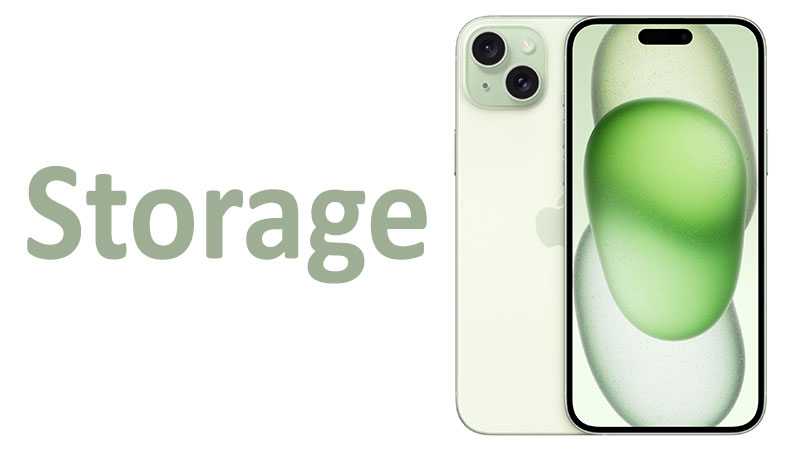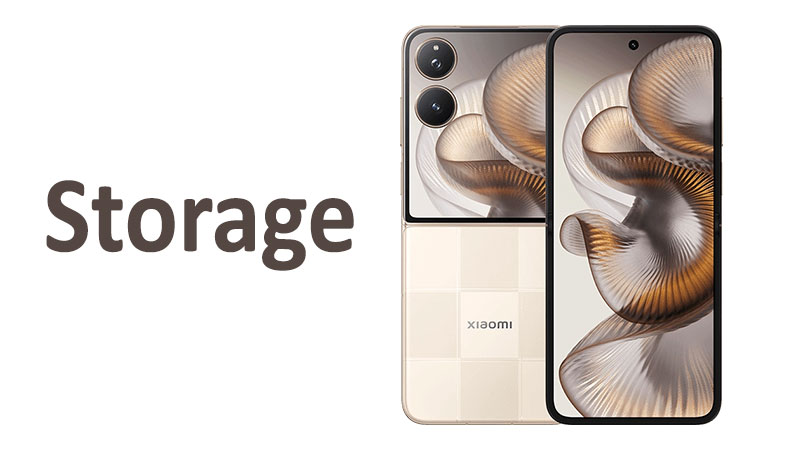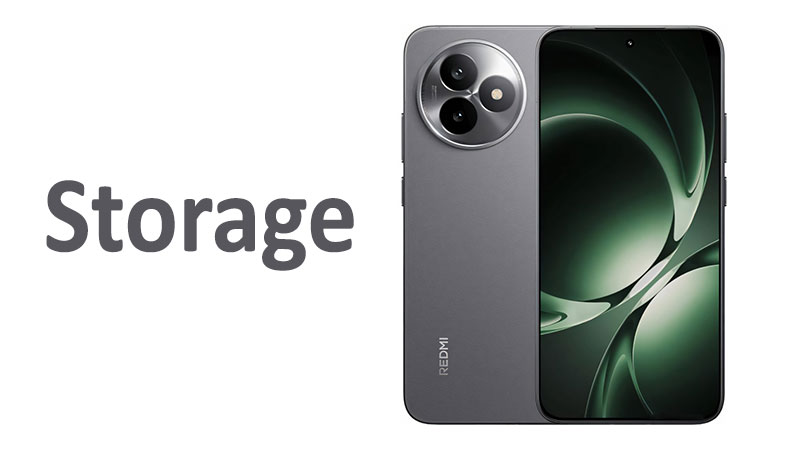The Apple iPhone 15 Plus storage system is a primary factor in the device’s performance and long-term usability. Selecting the correct capacity is perhaps the most important decision a buyer will make. This choice dictates how many years the iPhone remains viable without cloud reliance. The iPhone 15 Plus is a large-screen device. Therefore, users often utilize it for heavy media consumption and creation. Its storage technology must support these demanding tasks seamlessly. This comprehensive buyer’s guide explores every aspect of the iPhone 15 Plus internal memory. We will examine the capacity tiers, the technical NVMe standard, and vital purchasing considerations. Understanding these details helps you secure the perfect configuration for your digital life.
iPhone 15 Plus Storage Tiers: Configuration and Capacity Breakdown
The iPhone 15 Plus, like its smaller counterpart, provides a robust set of storage options. Apple designed these options to appeal to different budgets and data needs. The company maintains a high standard of performance across all models. This is achieved by unifying the RAM and storage technology. The resulting consistency ensures a predictable and fast user experience.
Standardized Configurations and Performance
The iPhone 15 Plus offers three main storage capacity tiers. Each capacity is paired with a fixed amount of 6GB RAM. This is crucial for maintaining operating speed. The 6GB of system memory handles multi-tasking and background processes efficiently. It works in tandem with the powerful A-series chip.
The available configurations are:
- 128GB Internal Storage with 6GB RAM
- 256GB Internal Storage with 6GB RAM
- 512GB Internal Storage with 6GB RAM
Apple’s tight integration of hardware and software is evident here. The 6GB RAM capacity is highly optimized for the iOS ecosystem. It prevents app closures and maintains smooth transitions. This unified approach simplifies the choice for the consumer. Buyers only need to focus on capacity, not on performance tiers.
The 6GB RAM Standard Explained
The iPhone 15 Plus features 6GB of high-speed LPDDR5 RAM. This is the phone’s working memory. RAM allows the processor to access active data quickly. While 6GB may seem smaller than some competitors, the optimization of iOS is key.
Apple’s operating system manages memory resources exceptionally well. It dedicates resources precisely where they are needed. This prevents system slowdowns that other phones might experience. The 6GB RAM is more than enough for everyday tasks. It easily handles browsing, social media, and demanding mobile games. This efficient management ensures the phone’s performance remains fluid and reliable.
Why 128GB is Still the Entry-Level Capacity
Apple continues to offer 128GB as the base storage option for the iPhone 15 Plus. This decision is primarily focused on price accessibility. It allows new buyers to experience the large-screen iPhone at the lowest possible cost.
However, 128GB capacity is increasingly restrictive for most modern users. The operating system and pre-installed apps already occupy a significant portion. This leaves the user with less than 120GB of usable space initially. Therefore, the 128GB option is specifically aimed at cloud-centric users. These buyers must be diligent about managing their photos and videos. They need to rely on services like iCloud for their media storage.
The Speed Advantage: Understanding NVMe Flash Storage
The responsiveness of the iPhone 15 Plus is rooted in its storage type. Apple utilizes proprietary NVMe (Non-Volatile Memory express) flash storage. NVMe is an advanced protocol. It allows the phone’s processor to communicate directly with the storage chips. This direct link bypasses older, slower interfaces. The result is industry-leading speed and efficiency.
What is NVMe and Why It Matters
NVMe storage is fundamentally a solid-state drive (SSD). It connects to the system via the high-speed PCIe bus. This connection provides tremendous bandwidth for data transfer. It drastically reduces latency, which is the delay before a transfer of data begins. Low latency is crucial for a fast-feeling operating system.
High NVMe speeds are important for all daily phone interactions. App loading times are minimized. Recording high-resolution video is seamless and instantaneous. Furthermore, installing large app updates is completed in seconds. These fast random read and write operations define the smooth performance of the iPhone 15 Plus. It is the engine that drives the iOS experience.
NVMe Performance Metrics on iPhone 15 Plus
While Apple does not publish detailed sequential speed metrics, performance benchmarks are readily available. The iPhone 15 Plus NVMe storage delivers impressive speeds. Sequential read speeds can often exceed 1,500 megabytes per second (MB/s). Sequential write speeds typically surpass 1,000 MB/s.
Crucially, the random read and write speeds are highly optimized. These speeds affect the subjective “feel” of the device. They ensure that all system-level tasks happen instantly. For example, opening a complex photo album or searching within the device library feels instantaneous. The NVMe system handles these intense storage demands without any visible slowdown. This guarantees a flagship-tier performance experience.
Comparison: NVMe vs. UFS 4.0 in Large Smartphones
Apple’s NVMe storage directly competes with the UFS 4.0 standard used in many top Android flagships. Both technologies offer exceptional speed. However, they achieve this speed through different architectures. UFS 4.0 is an industry standard. It boasts incredibly high sequential speeds. This makes it excellent for moving massive blocks of data.
NVMe is a proprietary solution tailored for iOS. It prioritizes low latency and optimized random performance. Random operations are vital for the responsiveness of the graphical user interface. Many experts argue that the iPhone’s NVMe provides a snappier, more fluid user experience. This is especially true during heavy multitasking. Ultimately, both standards are excellent. The iPhone’s NVMe ensures perfect hardware-software synergy.
Capacity Analysis: Choosing the Right Tier for Your Needs
The iPhone 15 Plus buyer must carefully select a storage tier. The larger screen often encourages more media consumption. This means data requirements are generally higher for Plus users. Understanding the limitations and benefits of each capacity is vital for making an informed choice.
128GB: The Cloud-Optimized Choice
The 128GB capacity is ideal for the budget-conscious consumer. It serves users who primarily use their phone for core communication and browsing. This user model is highly reliant on offloading data to cloud services.
Pros and Cons of 128GB
Pros:
- It offers the lowest entry price for the large-screen iPhone 15 Plus.
- It works well if you stream all movies and music, minimizing local downloads.
- The capacity is sufficient for a decent number of apps and essential photos.
Cons:
- You must manage storage aggressively, often deleting old files.
- High-quality video recording can fill the entire space in less than an hour.
- You cannot keep large mobile games installed simultaneously without issues.
Who Should Choose 128GB?
This option suits users who buy the iPhone for its size and battery life. They are not concerned with being a local data vault. They stream all their entertainment and actively use iCloud Photos or similar cloud platforms. This user sees the phone as a window to their data, not the storage container itself.
256GB: The Optimal Mid-Range Balance
The 256GB model hits the sweet spot for the vast majority of iPhone 15 Plus buyers. It offers a substantial increase in usable space over the 128GB model. This makes the phone more versatile for both media consumption and creation.
Pros and Cons of 256GB
Pros:
- It provides a comfortable buffer for a large media library and many apps.
- It significantly reduces the need for constant, annoying storage management.
- This capacity offers an excellent balance between cost and long-term utility.
Cons:
- It represents a notable jump in the total iPhone 15 Plus price.
- Extreme video creators might still fill it within the first year of ownership.
Who Should Choose 256GB?
The 256GB option is perfect for the enthusiast user. This person downloads several large games and shoots many 4K videos. They also keep hundreds of music tracks downloaded for offline playback. This user values the convenience of local storage for most of their digital assets. They only occasionally rely on cloud services for long-term archiving.
512GB: The Digital Maximalist Solution
The 512GB capacity is the maximum offered for the standard iPhone 15 Plus. It caters to the most demanding power users and content creators. This tier virtually eliminates all storage concerns for the device’s entire lifespan.
Pros and Cons of 512GB
Pros:
- It offers truly massive storage, providing ultimate data freedom.
- This capacity is essential for serious, high-volume video recording and editing.
- It allows the phone to serve as a complete, self-contained media library.
Cons:
- It demands the highest initial premium, making it a significant investment.
- Most average users will not utilize this entire capacity efficiently.
Who Should Choose 512GB?
This model is intended for professional mobile photographers and videographers. It is also for individuals who travel frequently and require vast amounts of media downloaded. These users need their phone to be a reliable, offline digital vault. They want to avoid any possibility of running out of space during a critical shoot.
Essential Buyer’s Guide: No Card Slot and Future-Proofing
Purchasing the iPhone 15 Plus requires a decisive up-front commitment to storage. The inherent design of the iPhone necessitates careful consideration. Buyers must plan for data growth because memory expansion is impossible.
The Critical Reality of Fixed Storage
The iPhone 15 Plus storage is non-expandable. There is no physical slot for a microSD card. Apple’s justification for this is twofold. First, removing the slot enhances the phone’s design and water resistance. Second, it enforces reliance on the faster, integrated NVMe memory.
This fixed storage constraint makes the initial purchase decision paramount. Buyers should not hope to manage their data with a cheap external card later. Whatever capacity you choose, that is your permanent limit. Therefore, buyers should always choose the capacity that offers them the most comfortable overhead. This prevents future storage frustration and costly device replacement.
Future-Proofing Your iPhone 15 Plus Storage
Future-proofing means ensuring your chosen capacity remains relevant for years. New generations of apps and operating systems constantly increase in size. High-efficiency video coding (HEVC) and higher resolution sensors mean larger file sizes for media.
Consider the phone’s expected lifecycle, typically three to five years. The 128GB model is the most vulnerable to obsolescence due to capacity limitations. The 256GB model offers a solid level of future-proofing for most consumers. However, if you are a heavy media consumer or creator, the 512GB configuration provides the best defense. It ensures you will not encounter capacity issues even years down the road.
Cost-Benefit Analysis of Capacity Upgrades
The price increments between the storage tiers are significant. Buyers must determine if the cost justifies the benefit of added space.
Moving from 128GB to 256GB provides 128GB of high-speed NVMe storage. This is an expensive upgrade on a per-gigabyte basis. However, you are buying peace of mind. You avoid the hidden cost of constantly managing files and cloud subscription fees. The trade-off is often worth it for the convenience alone. For the casual user, this may not be necessary. For the enthusiast, the time saved and frustration avoided easily justifies the higher initial cost.
Specialized Comparisons and Market Context
Understanding the iPhone 15 Plus storage in the context of the wider market provides valuable perspective. We can compare its features to the previous model, the Pro model, and its main competitors.
iPhone 15 Plus vs. iPhone 14 Plus Storage
The storage story between the iPhone 15 Plus and the iPhone 14 Plus is one of near-total consistency. Both models offered the 128GB, 256GB, and 512GB capacity tiers. Both also utilized 6GB of RAM. They both employed NVMe storage technology.
Therefore, an upgrade from the 14 Plus to the 15 Plus is driven by processor, camera, and display improvements. Storage performance remains nearly identical between the two generations. The storage speeds are already so high that any incremental improvement is negligible for daily use. Users upgrading can simply choose the same storage tier they used previously, or size up if their data needs have grown.
iPhone 15 Plus vs. iPhone 15 Pro Storage Differences
The primary storage difference lies in the top capacity and a specific performance feature. The iPhone 15 Pro models often extend the top tier to 1TB or even higher. This caters to the extreme demands of professional filmmaking.
Furthermore, Pro models may have features like ProRes video recording. These features generate massive files. Consequently, the lower 128GB Pro models sometimes face limitations on external recording speeds. The iPhone 15 Plus does not have these extreme professional video features. Thus, its 512GB top capacity is perfectly matched to its high-end feature set. The storage choices are appropriate for each device’s intended user base.
Competitor Comparison: iPhone Plus Storage vs. Android Flagships
High-end Android flagships, such as the Samsung Galaxy series, often offer UFS 4.0 storage. They also frequently include a microSD card slot for expansion. This provides a key difference in approach.
The Android method prioritizes raw capacity and budget-friendly expansion. The iPhone 15 Plus prioritizes peak, consistent performance. The integrated NVMe is faster and more reliable than any external memory card. Buyers need to decide which philosophy suits them best. Do you value ultimate speed and system integration, or do you prefer the flexibility of expandable, cheaper storage? The iPhone 15 Plus is a better choice for those prioritizing speed and simplicity.
Pros, Cons, and Key Takeaways
The iPhone 15 Plus storage solution is highly effective but comes with inherent limitations. Reviewing these points provides a balanced view for the potential purchaser.
Advantages of the iPhone 15 Plus Storage Architecture
The integrated NVMe system offers significant benefits to the user experience.
- Exceptional Responsiveness: NVMe technology ensures low latency, making all app interactions feel immediate and snappy.
- High Base RAM: The standardized 6GB RAM provides robust multitasking capabilities for all users.
- Reliability: Integrated NVMe storage is highly durable and less prone to corruption than external media.
- Optimal Integration: The hardware and iOS are seamlessly tuned for maximum storage efficiency and speed.
Disadvantages and Limitations
The choice to use fixed storage creates the primary constraints for the user.
- Fixed Capacity Lock-in: You cannot increase the storage after purchase. This forces meticulous planning.
- High Cost per GB: The price increment for larger capacities is significantly higher than buying a separate memory card.
- Storage Anxiety: Users must actively manage their data to avoid filling the capacity limit, especially on the 128GB model.
Final Purchasing Advice for Buyers
These critical points summarize the best advice for potential iPhone 15 Plus owners.
- Prioritize Capacity Over All Else: Because you cannot expand the storage, size up if there is any doubt about your future needs.
- Value Speed: Recognize that the iPhone 15 Plus storage is built for maximum speed and performance, not for storage budget.
- Choose 256GB for Balance: Most users will find the 256GB model offers the best long-term value and convenience. It is the safe middle ground.
- Account for Local Media: If you travel often, you need local storage for downloaded entertainment. Use the 512GB option for this heavy use case.
Conclusion
The Apple iPhone 15 Plus storage system excels in speed and performance consistency. The combination of NVMe flash memory and 6GB of optimized RAM guarantees a smooth, top-tier experience. The available capacities—128GB, 256GB, and 512GB—cater to a wide range of user demands.
The most critical factor in your decision is the fixed storage. This feature makes the initial capacity choice a permanent one. We recommend the 256GB configuration for the majority of buyers. It provides the ideal balance against the large price jump to the 512GB model. Meanwhile, it offers significantly more usable space than the 128GB base model. Professional creators and digital maximalists should undoubtedly choose the 512GB. Choosing the correct iPhone 15 Plus storage capacity ensures your device remains powerful, fast, and convenient throughout its entire lifecycle.
FAQ
Does the iPhone 15 Plus support external memory cards?
No, the iPhone 15 Plus does not support external memory cards. It has no physical slot for a microSD card.
What is the maximum storage capacity for the iPhone 15 Plus?
The maximum internal storage capacity available for the iPhone 15 Plus is 512GB.
Does the 128GB iPhone 15 Plus have the same speed as the 512GB model?
Yes. Both the 128GB and 512GB models use the same high-speed NVMe flash storage technology, ensuring identical speeds.
How much RAM is included in the iPhone 15 Plus?
The iPhone 15 Plus includes 6GB of LPDDR5 RAM across all of its available storage configurations.
What is NVMe storage?
NVMe is a high-speed storage interface. It connects flash memory directly to the processor for maximum data transfer speeds and low latency.



